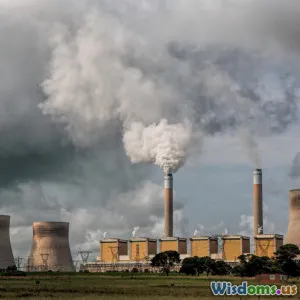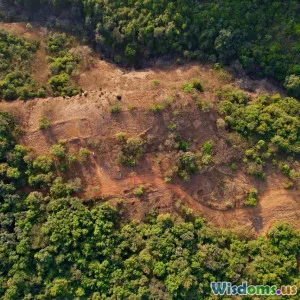
What Investors Need to Know About Carbon Offsets and Financial Returns
9 min read Explore how carbon offsets impact investors, revealing the intersection of environmental responsibility and financial returns. (0 Reviews)
What Investors Need to Know About Carbon Offsets and Financial Returns
Introduction
In an era of heightened environmental awareness and urgent climate action, carbon offsets have emerged as pivotal tools for investors seeking to reconcile profitability with sustainability. But beyond their green appeal lies a nuanced intersection of environmental impact, financial return, and regulatory complexity. For investors, comprehending the intricacies of carbon offsets is not only essential for making informed decisions but also offers opportunities to drive meaningful change -- all while managing risk and unlocking value.
This comprehensive article explores what investors need to know about carbon offsets and financial returns. We'll examine how offsets work, their evolving markets, the challenges related to their financial viability, and ways investors can navigate this landscape effectively.
Understanding Carbon Offsets
What Are Carbon Offsets?
A carbon offset represents a reduction in greenhouse gas emissions derived from projects or activities such as reforestation, renewable energy development, and methane capture. By purchasing offsets, entities compensate for their own emissions by funding equivalent emission reductions elsewhere.
For example, a company generating 10,000 metric tons of CO2 annually might buy offset credits from a wind farm project that prevents 10,000 metric tons of CO2 from entering the atmosphere.
Types of Carbon Offset Projects
- Forestry Projects: Reforestation and avoided deforestation projects generate offsets by sequestering carbon.
- Renewable Energy: Wind, solar, and hydro projects displace fossil fuel power generation.
- Methane Capture: Projects such as landfill gas recovery prevent methane, a potent greenhouse gas, from being released.
- Energy Efficiency: Upgrading industrial processes or buildings to use less energy reduces emissions and generates offsets.
Carbon Offsets vs. Carbon Credits
Often used interchangeably, they differ slightly. Carbon credits typically refer to the tradable units generated from emission reduction projects under regulatory schemes or voluntary standards. Offsets tend to be considered the actual emission reduction purchased by an entity.
--
The Financial Aspect of Carbon Offsets
Market Dynamics: Compliance vs. Voluntary Markets
- Compliance Markets: Created by government regulations like the European Union Emissions Trading System (EU ETS), where companies must meet mandated caps or buy allowances.
- Voluntary Markets: Corporations and individuals purchase offsets voluntarily to meet sustainability goals or enhance brand image.
To put numbers in perspective, the compliance carbon market exceeded $850 billion in 2023 globally, dwarfing the voluntary market, which was valued around $2 billion but is growing rapidly.
Pricing and Valuation
Carbon offset prices vary widely depending on project type, location, verification standards, and market conditions.
For example:
- High-quality forestry offsets certified under standards like Verified Carbon Standard (VCS) or Gold Standard can range from $10 to $20 per metric ton.
- Methane capture offsets can command higher prices due to their significant impact, sometimes exceeding $30 per ton.
This price volatility presents both opportunity and risk for investors seeking financial returns tied to offset projects or markets.
Financial Returns and Investment Opportunities
Carbon offsets can generate returns in several ways:
- Direct Project Investment: Investing in projects that produce offsets can create revenue streams through the sale of credits.
- Carbon Funds and ETFs: Specialized funds invest across carbon credit portfolios, trading credits as commodities.
- In-house Offset Generation: Large corporations integrate offset projects into their operations, potentially reducing compliance costs and creating new revenue streams.
Successful offset projects require upfront capital investment, often with long-term payback periods. For forestry projects, returns can come from both carbon credit sales and timber revenues.
Risk Factors Impacting Financial Returns
- Verification and Additionality Risks: Offsets must represent real and additional emission reductions. If projects fail verification, credits might become worthless.
- Regulatory Uncertainty: Changes in carbon regulations can dramatically affect offset demand and prices.
- Market Liquidity: Voluntary markets may lack liquidity, making entry and exit challenging.
- Environmental Risks: Natural events like wildfires can compromise carbon stocks in forestry projects.
Real-World Insights and Examples
Case Study: Apple’s Carbon Offset Strategy
Apple invested heavily in forestry and clean energy to offset its corporate footprint. By purchasing high-quality offsets and investing directly in reforestation projects, Apple not only neutralized significant emissions but also enhanced its brand equity and shareholder confidence.
Public-Private Partnerships
In countries like Costa Rica, government-led conservation efforts combined with private investments have resulted in successful carbon offset projects generating steady financial returns while preserving biodiversity.
The Role of Innovations
Technological advances such as blockchain are being used to improve transparency and traceability in offset markets. This innovation boosts investor confidence by mitigating fraud risks.
Data Point: Impact of Carbon Pricing on Investment Flows
According to a 2023 study by the World Bank, every $10 increase in carbon pricing correlates with a 15% rise in green investment globally, highlighting the financial potential tied to robust carbon markets.
Strategies for Investors
Due Diligence: Evaluating Offset Projects
- Certification: Ensure projects are certified by recognized standards (e.g., VCS, Gold Standard).
- Permanence: Assess the durability of emission reductions.
- Co-benefits: Consider environmental and social benefits which enhance project value.
Diversification Across Project Types and Geographies
Allocating capital across various types of offset projects mitigates specific risks related to regional or sectoral vulnerabilities.
Engaging with Carbon Markets
Active participation in compliance or voluntary markets, including trading carbon credits, requires granular market knowledge and risk management expertise.
Aligning Offset Investments with ESG Goals
Integrating offset purchases in an overall Environmental, Social, and Governance (ESG) investment framework can appeal to stakeholders and impact investors focused on sustainability.
Conclusion
Carbon offsets represent a compelling, albeit complex, frontier for investors aiming to blend environmental stewardship with financial gain. While offset markets offer innovative vehicles for mitigating climate risk and generating returns, they require careful navigation amid regulatory shifts, market volatility, and validation challenges.
For investors, the key lies in rigorous due diligence, diversification, and aligning offset investments with broader sustainability commitments. By doing so, investors not only hedge against emerging risks associated with climate change but can also capitalize on the burgeoning carbon economy.
Ultimately, understanding carbon offsets in-depth opens doors to transformative investment opportunities—where capital meets climate action, driving value for portfolios and the planet alike.
Embrace the future of investing: capitalize on carbon offsets with insight, prudence, and impact.
Rate the Post
User Reviews
Popular Posts




















